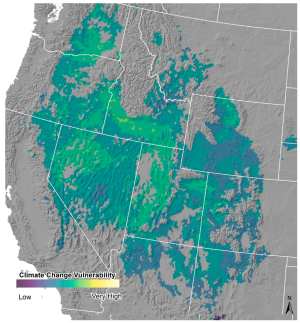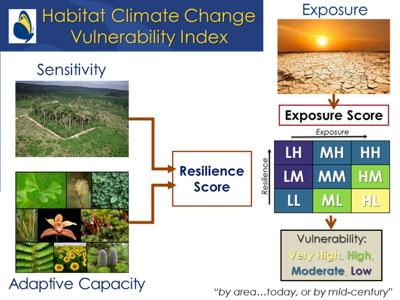We applied a framework to assess climate change vulnerability of 52 major vegetation types in the Western United States to provide a spatially explicit input to adaptive management decisions. The framework addressed climate exposure and ecosystem resilience; the latter derived from analyses of ecosystem sensitivity and adaptive capacity.
Measures of climate change exposure used observed climate change (1981–2014) and then climate projections for the mid-21st century (2040–2069 RCP 4.5). Measures of resilience included (under ecosystem sensitivity) landscape intactness, invasive species, fire regime alteration, and forest insect and disease risk, and (under adaptive capacity), measures for topo-climate variability, diversity within functional species groups, and vulnerability of any keystone species. Outputs are generated per 100 km2 hexagonal area for each type.
 As of 2014, moderate climate change vulnerability was indicated for >50% of the area of 50 of 52 types. By the mid-21st century, all but 19 types face high or very high vulnerability with >50% of the area scoring in these categories. Measures for resilience explain most components of vulnerability as of 2014, with most targeted vegetation scoring low in adaptive capacity measures and variably for specific sensitivity measures. Elevated climate exposure explains increases in vulnerability between the current and mid-century time periods.
As of 2014, moderate climate change vulnerability was indicated for >50% of the area of 50 of 52 types. By the mid-21st century, all but 19 types face high or very high vulnerability with >50% of the area scoring in these categories. Measures for resilience explain most components of vulnerability as of 2014, with most targeted vegetation scoring low in adaptive capacity measures and variably for specific sensitivity measures. Elevated climate exposure explains increases in vulnerability between the current and mid-century time periods.
